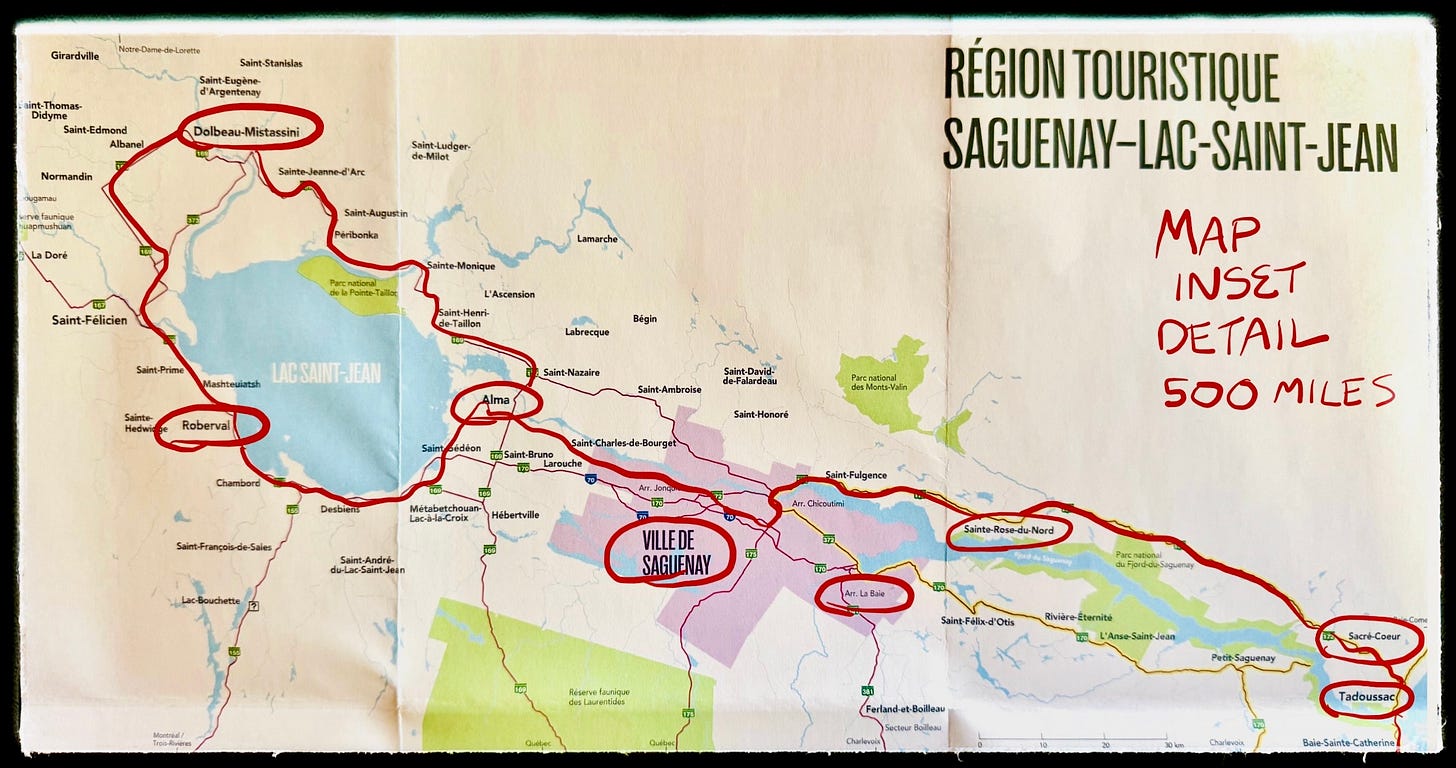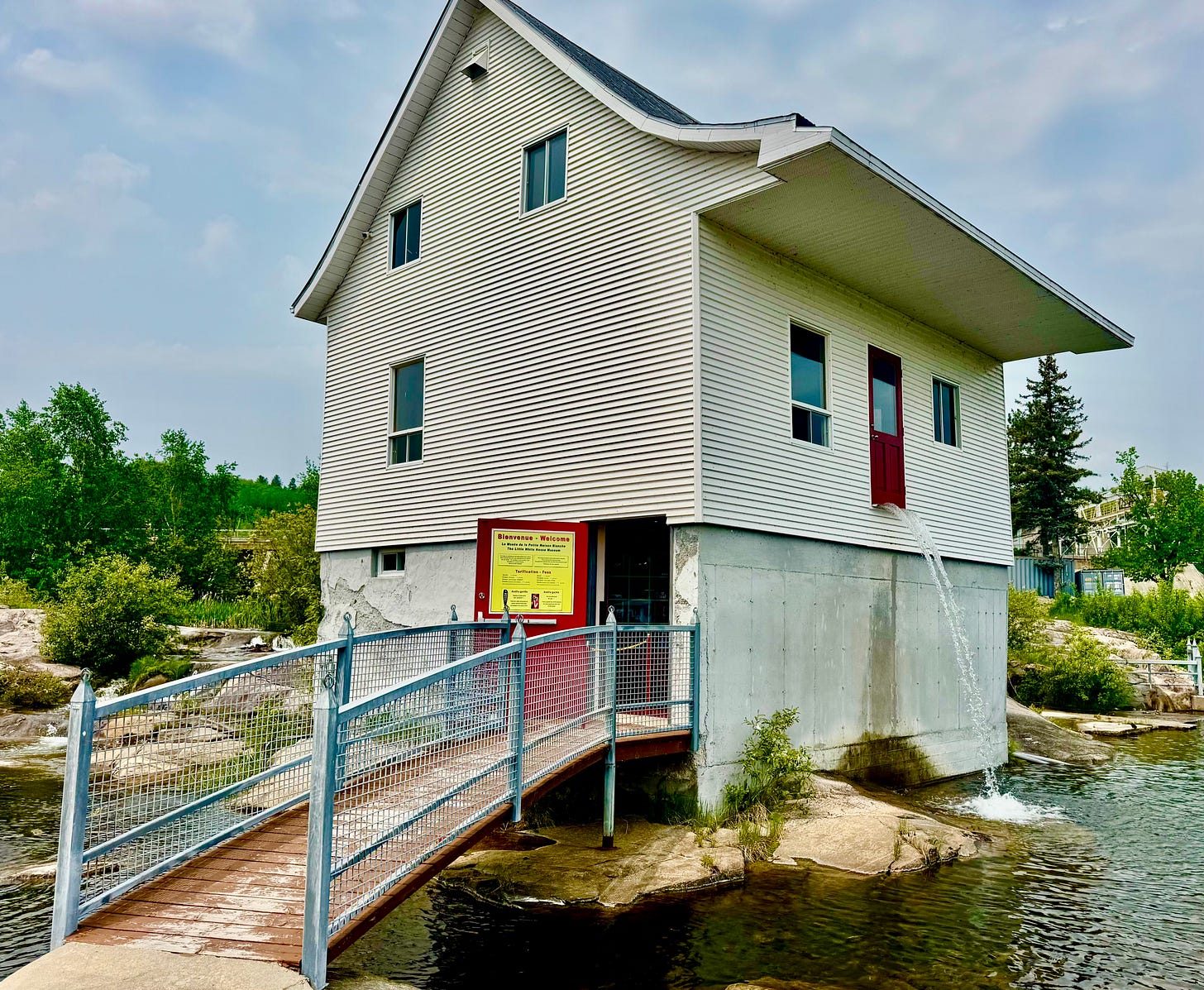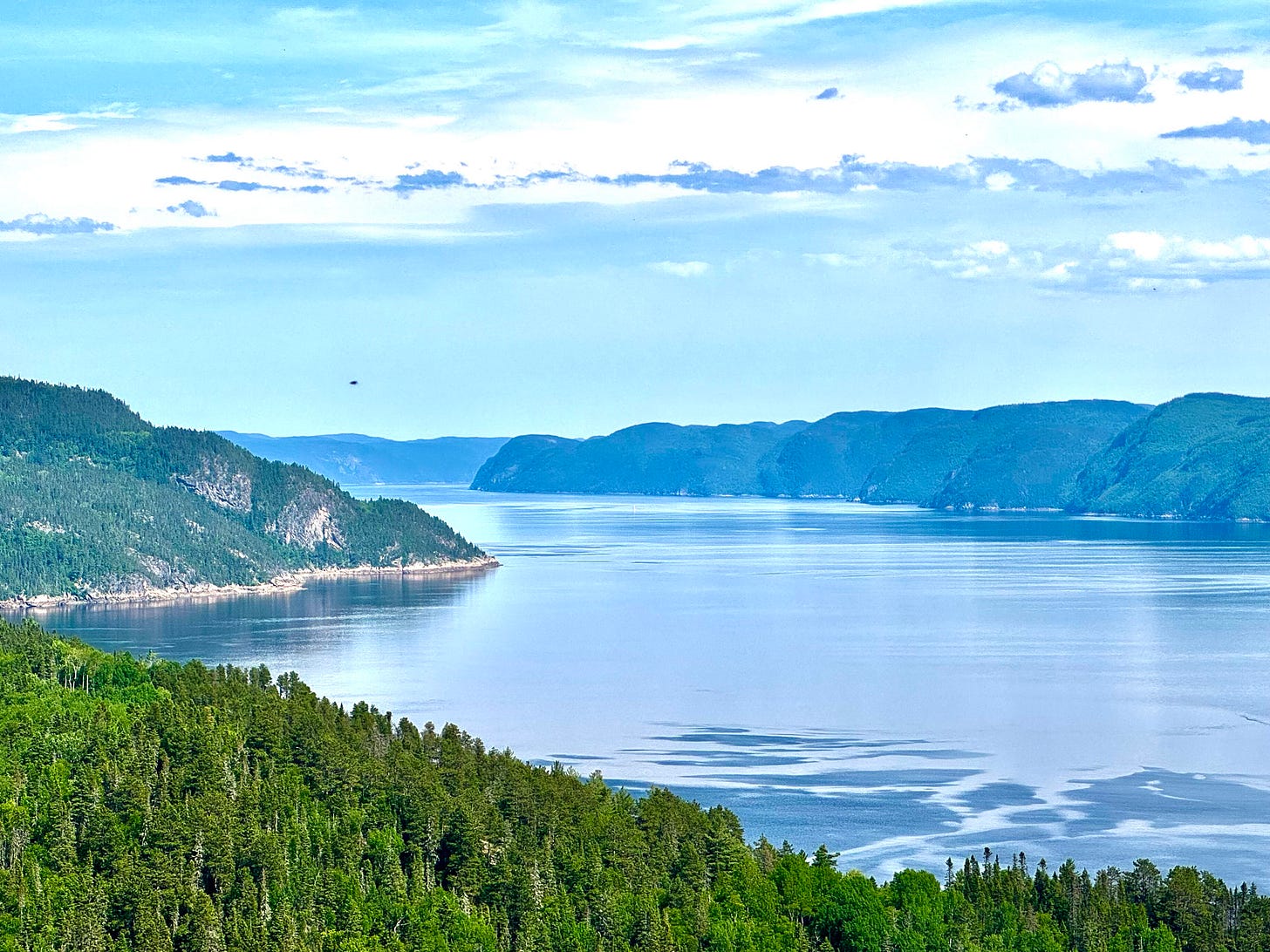Bittersweet Comparisons; Biking in Quebec to Saguenay and Lac Saint-Jean
Writing by Michael Chase, Drawings by Jenny Hershey
We met our Airbnb host, Alexandre, in Saguenay, Quebec, after he rescued us from a faulty entrance lock. Exhausted and needing rest, he told us about his work as a helicopter pilot for the Canadian company Geotech. His job takes him to North America’s most remote locations, flying geologists who use sophisticated instruments to detect and map deeply buried rare earth deposits - critical materials for modern batteries. The conditions are often brutal and dangerous. Meeting Alexander reminded us that behind every technological revolution are people willing to take remarkable risks. While we ride bicycles up and down hills and fumble with simple door locks, he spends his days threading helicopters through remote terrain, carrying millions of dollars worth of sensitive equipment, all in service of finding materials that may either secure our future through clean energy or potentially destroy us through unregulated AI or Robots. His combination of everyday kindness and extraordinary professional courage made Alexandre the kind of host - and person - we won’t soon forget.
Our Northern Neighbor
We crossed into Canada on June 2, 2025. Anticipating potential difficulties at the border, Jenny and I opted to bypass the busy Interstate 87 route and headed to Rouses Point, NY - where the Richelieu River canal meets Lake Champlain. Crossing into Canada on a quiet rural road is always a pleasure, and this trip was no exception. The lone Canadian Customs agent greeted us with warmth, making the experience refreshingly easy. Before we knew it, we found ourselves apologizing for our President’s treatment of Canada. She smiled and said, “Lots of Americans passing through here are saying that.” Then, with no muss and no fuss, we were on our way.
A general map with an inset outlines our route. We left our car at Quebec City Airport and cycled up the southern side of the Saint Lawrence. Crossing the river by ferry at Rivière-du-Loup, we arrived in Saint-Siméon before following the Saguenay Fjord to Saguenay - a municipal entity incorporating the former cities of Chicoutimi, La Baie, and Jonquière. From there, we circled Lac Saint-Jean clockwise before returning to Saint-Siméon and making our way back to Quebec City along the rugged northern shore of the Saint Lawrence.
Their Southern Neighbor
The moment we crossed into Canada, we breathed sighs of relief. It wasn’t just the orderly customs or polite border guard—though those helped. Jenny put it best: “Isn’t it great to be somewhere Trump isn’t in charge?” I nodded: “Yes, it feels so… normal.”
That word lingered as we drove deeper into the country. What we felt wasn’t unique - we’d stumbled across a continental divide where seamless friendship between neighbors is quietly fracturing.
Canadian attitudes toward the U.S. have soured dramatically since 2024. Seventy-three percent now view their southern neighbor unfavorably, fueling the “Choose Canada” movement - a cultural shift redefining national identity. Instead of traditional winter pilgrimages south to the US, Canadians are exploring Mexico, Costa Rica, and the Caribbean while also rekindling their appreciation for home - exploring provincial parks and coastlines with renewed enthusiasm.
In Quebec, this plays out in miniature. Everywhere, French-Canadian families and solo travelers cycle past, embracing local trails once overlooked for cross-border trips. It’s a small but telling sign of an inward turn - a nation choosing home over uncertain terrain to the south.
Our relief at crossing mirrors broader Canadian sentiment since Trump’s return: the U.S. has lost its way and no longer feels welcoming or safe.
The sun sets over the Saint Lawrence in Berthier-sur-Mer, northeast of Quebec City, in early June 2025.
The Economic Toll
The diplomatic freeze with Canada is bleeding American dollars. The World Travel and Tourism Council projects $12.5 billion in lost international visitor spending for 2025. Canadian tourists normally inject $20.5 billion annually into the U.S. economy - money now spent elsewhere or kept at home.
American border communities are suffering. New York, Vermont, and Washington border towns that depend on Canadian shoppers face sales declines up to 50%, with walk-in traffic dropping over 80%. Sault Ste. Marie, Michigan reports hotel bookings down 77%. Montana businesses see 20-40% drops in Canadian visitors. From Florida to the Gulf Coast, restaurants and motels struggle under fractured cross-border trust.
The irony is stark: while Ottawa imposes gentle retaliatory measures, individual Canadians and the tourism sector remain welcoming toward American travelers. Still, a word to the wise - jokes about Canada becoming the 51st state don’t land well these days.
What was once North America’s most peaceful relationship now serves as a cautionary tale of how quickly trust between nations can unravel.
As we biked the 64 miles from Sacré-Cœur to Saguenay, climbing over 3,200 feet in smoke filled air, we found ourselves living the climate story we’re trying to tell in this newsletter. Smoke from British Columbia and Alberta fires, plus additional fires in northern Quebec, had settled over central Quebec. Within days, the same poor air quality (AQI >150) would blanket Quebec City, Montreal, and Toronto. We’d never been forced to bike in such compromised air before - suddenly we were no longer just reporting on climate impacts, we were breathing them.
A screen shot of a map from OnXBackcoutry showing air quality over parts of Quebec (and the US) on June 5, 2025: red regions are AQI above 150, orange 100-150, and yellow 50-100. Air quality becomes dangerous above 50 AQI.
A Region in Transition
The Saguenay - Lac-Saint-Jean region faces disruptive climate change. The Ouranos Consortium projects average temperatures will rise 5°F by 2050, forcing communities from Saguenay to lakeside towns like Saint-Félicien and Roberval to dramatically adapt.
Extreme weather isn’t new here. The 1996 Saguenay flood - the most devastating in 20th-century Canadian history - sent eight feet of water through Chicoutimi, destroying entire neighborhoods, killing 10 people, displacing 16,000 residents, and causing $1.5 billion in damage.
Yet tragedy sparked transformation. The disaster led to sweeping reforms: new dam security laws, mandatory emergency plans, and flood zone mapping - all driven by the groundbreaking Nicolet Commission. What made this commission exceptional wasn’t just its technical rigor in engineering and risk assessment, but its attention to flood victims’ lived experiences. Commissioner Roger Nicolet “facilitated a collective act of storytelling and grieving, giving voice to thousands who had felt devastated and unheard.”
This dual focus on scientific precision and human truth created more than policy recommendations - it forged a humanized blueprint for resilience that remains invaluable as Canadian communities face climate change’s mounting challenges.
The flood’s iconic symbol, a small white house that survived the 1996 flood, still serves as a museum in Saguenay as a reminder of both nature’s power and human resilience.
Extreme Weather on the Rise
Saguenay faces escalating climate threats: heavy downpours, floods, erosion, landslides, forest fires, and heat waves. The 2024 summer alone cost millions in emergency infrastructure repairs, while 2023’s wildfires forced evacuations and left residents with lingering health effects from smoke that also choked Chicago, New York, and Washington.
The 2023 wildfire season marked a turning point. Record-breaking fires consumed over 4.5 million hectares across Quebec, which - despite being historically less fire-prone than western Canada - produces more intense blazes that threaten populated areas. Quebec now has Canada’s highest wildfire exposure, especially in central and northeastern regions.
Yet Saguenay residents refuse to be passive victims. Local municipalities actively implement climate initiatives under Quebec’s “Plan for a Green Economy 2030” and participate in the federal “Partners for Climate Protection” program - a network of over 400 Canadian municipalities combating climate change together. While the federal government provides scientific research and forecasting data, resilience planning and disaster response remain with local authorities, ensuring community-tailored solutions.
We met Marie B in the tiny town of Sainte-Rose-du-Nord, nestled in the heart of the Saguenay fjords. She was running the tourist center alone, and we were the only visitors so early in the season. Marie told us how, as a child, she would travel north from Chicoutimi to spend summers at her grandfather’s mountain house. Her knowledge of the area was impressive. When Jenny asked her about the devastating 1996 Saguenay flood, her face grew serious. Marie B. remembered it vividly - her town was overwhelmed when dams breached after torrential rains. Spreading out a map, she showed us where friends and family lived along the river and described how they were cut off for weeks as bridges and roads washed away. Now she’s content living in this small hamlet, perched safely above the river’s edge.
US and Canadian Disaster Response Strategies
Over the past five months, the U.S. has dismantled climate research and disaster management at unprecedented speed. Federal agencies have eliminated climate programs, slashed budgets, gutted workforces, and reversed policies - crippling America’s ability to monitor and respond to climate change.
Since January, over 2,000 FEMA employees have been terminated and NOAA’s research budget cut from $485 million to $171 million. The $4.6 billion resilience program BRIC has been canceled, National Weather Service offices operate with 44% vacancy rates, and FEMA will phase out after the 2025 hurricane season. States now scramble for funding to build emergency capabilities that has not been their responsibility before now. Elon Musk’s DOGE frames these cuts as cost-saving. In reality, they endanger public safety and weaken disaster resilience, leaving communities more vulnerable than ever.
Meanwhile, Trump pushes tax cuts benefiting his wealthy patrons while dismantling healthcare access and reversing climate strategies. Most alarming: this legislation would raise the deficit by $2.5 to $5 trillion, rendering DOGE’s supposed savings meaningless.
A view from Saint Fulgence just east of Chicoutimi on the Saguenay Fjord. We are almost 125 miles inland from the Saint Lawrence, and there is still a tidal flow.
The U.S. vs. Canada: Two Diverging Paths
As a result of this upheaval, comparing U.S. and Canadian approaches to disaster preparation has become increasingly difficult. Like the 194 countries plus the European Union that remain parties to the Paris Agreement, Canada still acknowledges the reality of climate change and maintains steady mitigation, resilience, and recovery strategies. (Quebec’s story on this subject is a very hopeful one, and is covered later in this newsletter.)
Consequently, Canada’s system remains stable and robust, reinforcing a sense of security for those who rely on it— Jenny and me included, given that extreme weather is more and more likely to happen to us anywhere at any time on our biking trips.
Yet, in the U.S. under Trump, climate change - and the science that backs it up - no longer exists. In February, DHS Secretary Noem ordered the elimination of “all climate change activities and the use of climate change terminology in DHS policies and programs.” FEMA staff were required to remove terms including climate resilience, global warming, and social justice from all documents. The agency’s 2022–2026 Strategic Plan, which prioritized climate resilience, was wiped from FEMA’s website.
A generation ago, Republican figures like George Bush often rallied around the steady refrain of “stay the course.” In the MAGA era, the impulse seems reversed: “if Democrats value it, blow it up - regardless of the fallout.”
Federal vs. State-Level Disaster Response
Republican talking points about local disaster management efficiency have some validity. The U.S. has operated a complex, federally oriented model with massive but volatile funding, while Canada uses a collaborative federal-provincial framework with more efficient spending and steady policy evolution.
The most striking difference lies in how authority flows. Until recently, the U.S. centralized power in FEMA through 600 active declarations and 10 regional offices. FEMA still depends on presidential disaster declarations, creating a reactive system where states must prove overwhelming need before receiving help - a cumbersome and politicized process.
Canada’s collaborative federalism coordinates rather than controls, working through provincial structures that respect constitutional divisions of power. This predictable system allows provinces to retain primary responsibility while accessing federal support through established protocols rather than political declarations. Canada’s sliding cost-share formula also ensures predictable outcomes: provinces cover initial costs up to $3.84 per capita, while federal contributions scale from 50% to 90% based on disaster magnitude.
The U.S. has historically spent far more on disaster recovery. FEMA’s Disaster Relief Fund has averaged $16.5 billion annually since 2005, totaling $347 billion over 30 years. However, Canada has only 11% of the U.S. population and faces fewer climate disasters due to geography. Canada’s Disaster Financial Assistance Arrangements program spent $9 billion total since 1970, though recent climate impacts have triggered dramatic increases - $1.27 billion in 2023-24 alone, largely due to expensive wildfires.
Louise often dreamed of life on a motorcycle, growing up with three brothers in Saint-Hubert, just outside Montreal. But life had different plans for her. After two long, yet unfulfilling marriages, a successful career as a fashion designer, and raising four children she deeply adores, Louise found herself again yearning for the adventurous life she’d always dreamt of in her youth. Instead, she found herself swept away by a life lacking spirit and adventure. But then along came Yvon, husband number three, with a gentle spirit and a sense of adventure. Yvon also came with a classic Honda motorcycle. So off they went. Like so many other couples we met in the Saguenay-Lac-Saint-Jean region, Louise and Yvon travel freely by motorcycle. Louise now embraces her freedom, enjoying her next great chapter, hugging the back of her man. When at home, Louise and Yvon live a simple life in their empty nest in Bromont, in Quebec’s Eastern Townships.
Quebec’s Clean Energy Transformation
Quebec’s ban on natural gas fracking showcases how grassroots resistance can reshape energy policy, transforming the province into the world’s first jurisdiction to completely prohibit oil and gas exploration.
The story began around 2008 when hydraulic fracturing debates emerged across Quebec’s gas-rich shale formations in the St. Lawrence Valley. While companies identified potentially massive reserves, a powerful grassroots coalition of environmentalists, farmers, hunters, labor activists, Indigenous nations, and politicians mobilized against what they saw as a threat to their communities.
The resistance succeeded quickly. In 2012, Quebec imposed a five-year fracking moratorium between Montreal and Quebec City. This expanded in 2018 to provincewide restrictions under Energy Minister Pierre Moreau, who emphasized “caution” as Quebec wrote “the story of the energy transition.”
The culmination came in April 2022 with Bill 21, making Quebec the first government worldwide to explicitly ban oil and gas development and mandate closing existing drilling sites within three years. This historic victory followed 15 years of citizen mobilization, with activists blocking an estimated 20,000 fracking wells across the province.
What makes Quebec’s approach particularly forward-looking is pairing fossil fuel restrictions with aggressive renewable energy expansion. The province already generates nearly 100% of its electricity from renewable sources, primarily hydroelectric power. Hydro-Québec, North America’s largest hydroelectric producer, is implementing Action Plan 2035 to triple Quebec’s wind capacity and invest $155-185 billion in clean energy infrastructure.
The utility plans to develop 11,000 MW of clean energy in the next decade—equivalent to 50% more than all Greater Montreal’s consumption. This includes expanding hydroelectric capacity, developing major wind farms, and exploring solar and battery storage.
Quebec’s clean energy investments create substantial economic opportunities, with projections that additional hydrogen and bioenergy projects could generate $10 billion in provincial economic activity. The province plans to phase out fossil fuel heating in homes by 2040, requiring complete transition to renewable residential heating.
Like a river changing course to find a more efficient path to the sea, Quebec has redirected its energy future from extractive industries toward renewable abundance. As a global renewable leader, Hydro-Québec supplies 8 million Quebecers with 99% clean power while contributing $4.5 billion annually to the provincial government. Quebec’s journey from fracking battleground to clean energy powerhouse demonstrates that with political will and citizen engagement, jurisdictions can lead the clean economy—creating jobs, protecting environments, and building sustainable prosperity for generations.
Sometimes the best travel experiences come from unplanned detours. When Jenny took a hard spill on a gravel road outside Sainte-Rose-du-Nord, what should have been a brief stop in this northern Quebec hamlet became an unexpected three-day sanctuary. We found refuge in a classic wooden mountain house, perched on a hillside overlooking the local graveyard - with a stunning view of the Saguenay Fjord. With Jenny nursing skin abrasions, a bruised hip and a painfully swollen shoulder, the slower pace was exactly what we needed. “Closest grocery store is 30 miles,” Jacques mentioned casually, as if this were perfectly normal. It is, for him. But rather than leave us stranded, he offered to pick up supplies during his next town run - the kind of effortless hospitality that only exists in places where neighbors still look after each other.
Jacques embodies the rhythm of this isolated region. Half his life unfolds in extreme remoteness: he helicopters into northern Quebec mines where he feeds up to 1,000 workers for two-week stretches. The other half plays out in deliberate stillness, recovering in this village where he’s planted deep roots. Jacques speaks of winters past when snow drifts swallowed his garage whole, though he’s quick to note that recent years have been gentler. Still cold enough for ice fishing - his favorite winter ritual - but nothing like the bone-deep cold of his youth. Now he’s investing in permanence, having recently purchased a substantial piece of a mountainside nearby where he’s building a home to retire in.
Full Circle
The U.S. government’s disaster management system is clearly in disarray. Like a ship constantly changing course, Trump’s administration acts impulsively, recognizing policy consequences only after donors or MAGA politicians intervene. His recent reversals on deporting hotel and construction workers, or his tariff deal with China that ended where it began - except now China knows it can inflict more economic pain than it receives - illustrate this pattern.
The impulsive dismantling of disaster management will likely be partially reversed, though not through foresight. As disasters strike with increasing frequency and severity, cash-strapped states will shoulder greater financial burdens, potentially driving better localized responses - but only with intelligent federal oversight. That story belongs to the next administration, not this one.
Regarding climate science or sensible energy policy, effective governance under Trump remains doubtful. That crisis, too, is deferred to an even more threatening future.
Above the small village of Saint Rose du Nord on the north side of the Saguenay Fjord is a viewing platform that offers visitors an extraordinary view looking east toward Tadoussac.
Nearing the end of our journey around Lac Saint-Jean and along the Saint Lawrence’s north shore, we return enriched by more than stunning scenery. This trip offered ground-level insight into how neighboring countries face global challenges.
Cycling through Quebec’s northern wilderness and charming towns, we had conversations with locals that - despite our poor French - revealed how communities on both sides of the border are handling political upheaval. The differences between U.S. and Canadian approaches to disaster preparedness are as strikingly different as their politics, yet one lesson emerges: effective disaster management isn’t about grand gestures but steady, practical preparation and communities working together before crisis strikes. Like cycling hundreds of miles, building resilience requires consistent effort and long-term commitment.
Both nations face difficult roads ahead, but the local adaptability and cooperation we’ve witnessed in Quebec inspire cautious optimism. Whatever storms - literal or figurative - await around the next bend, we leave here more aware, more prepared, and more hopeful that collective action will chart a stabler future.
Postscript
The Head mechanic Andrew at Propel Bikes (propelbikes.com) standing to the right of our sales expert Arthur in New York City after servicing Michael’s Riese and Muller Roadster. We are very pleased with the durable and high performing bicycles that we purchased from them, and their customer service is terrific. We hope our new bikes will give us years of rugged and challenging riding. So far, so good!
And this is Jenny standing next to her reliable old Prius with our QuikRStuff (quikrstuff.com) bike rack. We love this rack!
Stay vigilant! Thanks for reading. If you haven’t done so, please subscribe to this blog to follow our next biking trip.
This newsletter was written by Michael Chase, and illustrated by Jenny Hershey. Unless otherwise noted, all material is the copyrighted property of the authors, including all photographs and drawings.
Jennifer Hershey’s drawings can be enjoyed on Instagram @deeofo.
Sources
Border
https://angusreid.org/trump-tariffs-canada-retaliation-usa/
https://www.newsweek.com/canada-us-relations-enemy-poll-tariffs-2034766
https://leger360.com/us-as-ally/
https://wttc.org/news/us-economy-set-to-lose-12-5bn-in-international-traveler-spend-this-year
Climate
https://www.ouranos.ca/en/news/2024-05-15/2024-forest-fire-season
https://www.watercanada.net/tag/the-nicolet-commission/
https://ici.radio-canada.ca/rci/en/news/1985868/quebec-fire-update-wednesday-legault
https://ville.saguenay.ca/services-aux-citoyens/environnement/developpement-durable/plan-climat?
https://www.quebec.ca/en/government/policies-orientations/plan-green-economy
https://ville.saguenay.ca/services-aux-citoyens/environnement/developpement-durable/plan-climat
https://en.m.wikipedia.org/wiki/List_of_parties_to_the_Paris_Agreement
https://www.reuters.com/article/canada-quebec-fracking-idUSL2N0DW33620130515/
https://breachmedia.ca/how-quebec-won-the-worlds-first-ban-on-oil-and-gas-extraction/
https://www.energyhub.org/targets/
https://businessrenewables.ca/resource/quebec-begins-red-carpet-roll-out-renewable-energy
https://www.innovationnewsnetwork.com/quebecs-role-in-the-battery-metals-supply-chain/22581/
https://www.greencarcongress.com/2020/11/20201117-quebec.html
https://www.hydroquebec.com/clean-energy-provider/markets/new-england.html
















